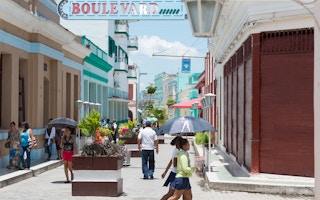With the urban population swelling the world over, it makes sense that we start—or go back to—designing cities for people too. People are a city’s principal raison d’etre. Cities therefore should be designed or redesigned to address one aspect that is at a more personal level for residents to make it greener: walkability.
To continue reading, subscribe to Eco‑Business.
There's something for everyone. We offer a range of subscription plans.
- Access our stories and receive our Insights Weekly newsletter with the free EB Member plan.
- Unlock unlimited access to our content and archive with EB Circle.
- Publish your content with EB Premium.
In megacities like Manila or Jakarta, it is crucial to have sustainable, well-planned, clean, and affordable public transport. However, we must remember that while making a city more walkable makes it more livable and attractive, it also encourages the use of, and requires the availability of, sustainable public transport.
But what is walkability? Is a city’s availability of sidewalks enough to say it is walkable? Add a few green spaces—is it then walkable? How about disability access and safety? Would a high-density city with no gaps as far as accessibility (i.e., sidewalks and disability access don’t end abruptly) between home, retail, and work areas by foot or public transport make it walkable if there remains a high incidence of pedestrians hit by cars each day? Travel and mobility should be a pleasant part of the landscape, rather than forcing pedestrians across multiple lanes of fast-moving traffic, for example.
In Asia, many of its cities have paid little attention to the demand and availability of pedestrian facilities. In the Philippines, while about 2 million Filipinos own private vehicles, the remaining 98 million who cannot afford cars—or choose not to have one—have no other choice but to walk, cycle, or take public transport. Unfortunately, while there is a lack of proper sidewalks, public transportation is also unsafe, inconvenient, crowded, and unreliable. This lack of walkability hardly makes any city inclusive, green, livable, or sustainable.
A city designed with the human foot in mind is also designed with people’s needs in mind. Increased walkability helps improve resource responsibility, safety, physical fitness, and social interaction. The social interaction then leads to communities that are thriving, livable, and sustainable, providing residents with safe transportation choices and improved quality of life.
“
While increasing the number of clean, safe parks, sustainable public transport, recreational facilities, shops, and services have proven to increase daily walking and, consequently, healthier lifestyles, walkability serves businesses a great deal of good too.
While increasing the number of clean, safe parks, sustainable public transport, recreational facilities, shops, and services have proven to increase daily walking and, consequently, healthier lifestyles, walkability serves businesses a great deal of good too. Businesses can take advantage of increased pedestrian traffic. Providing clean, safe sidewalks increases the number of pedestrians in a business district, encourages leisurely browsing, and leads to unplanned purchases which are good for local merchants.
Such was the case in Pune, India, where Mahatma Gandhi Road was converted to a vehicle-free walking plaza from 4 p.m. to 6 p.m. on Saturdays and Sundays. The city resurfaced the road and brought in streetlights, footpaths, and beautification. The once congested commercial road now bustled with between 10,000 and 20,000 pedestrians each weekend where families and children could play, move, and chat along the plaza.
Businesses previously against the walking plaza—because their business on Saturdays initially dropped by 80 per cent—eventually began to attract more business than they had prior to the road closure. Sound and air pollution also decreased between 40 per cent and 50 per cent, according to a 2013 study on “Green Urbanism in Asia.” Now there’s a good use of space: livable, sustainable, and inclusive—for people, not cars.
There is an old Native American proverb that says, “We do not inherit the earth from our ancestors, we borrow it from our children.” Keeping this in mind, there is only one gauge that should apply when determining if a city is walkable or not: Is it safe for our children? Are there safe parks or plazas for kids to play? Can they walk to and from school, parks, and public transport safely? Is the air safe to breathe? Can parents be confident enough to roam the city with a child in a stroller? If so, then it is safe, livable, and inclusive for everyone, and everyone benefits. Once the streets are safe for children, it attracts more families, more people, and more business.
If cities can shift their focus back to people’s quality of life, the rest, such as economic growth, usually follows.
Amy Leung is director of the Urban Development and Water Division, Southeast Asia Department, Asian Development Bank (ADB). This post was originally published on the ADB blog.











